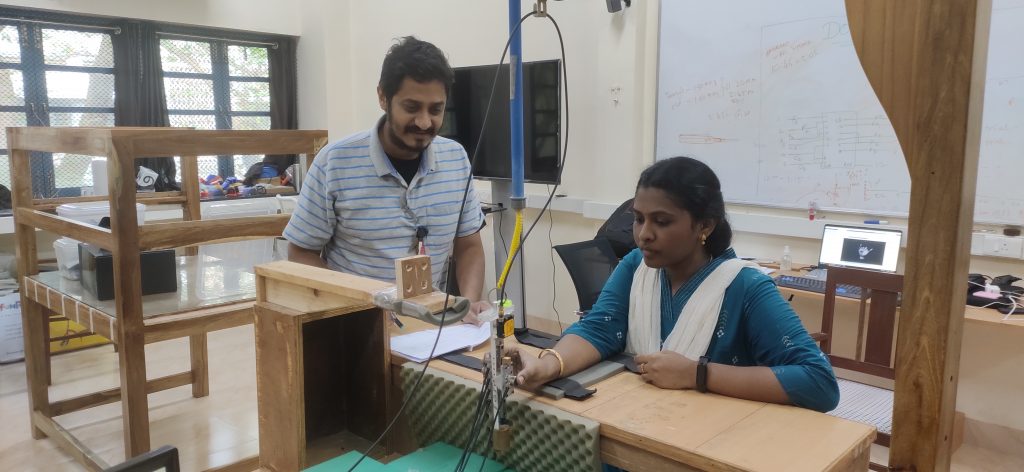
Grasping an object is one of the most common everyday activities we do with our hands. Object stabilization while grasping is equally essential for the safe handling. For example, a cup of coffee held in hand has to be vertically oriented without tilting in any direction in order to avoid spilling. Among all the fingers in the human hand, the thumb plays a remarkable role in maintaining the grasped object stable. In case, if the thumb is placed on an unsteady platform while holding an object, how the other fingers would contribute in sustaining the stability was questioned. Therefore, a five-finger instrumented grasping handle made of aluminium was designed with a vertical railing on the thumb side over which a slider platform was placed. Five finger force sensors were mounted on the handle to measure the forces of the fingers and thumb while holding the handle stable.
Due to this unsteady thumb platform while holding an object, the handle tends to rotate in the counter-clockwise direction. Index and little fingers are the peripheral fingers considered to establish stabilization when there are torque changes to the grasped handle. In general, between the peripheral fingers, little finger is found to contribute less grip force than the index finger. The little finger is always considered as a weaker finger when compared with other fingers of the human hand. However, due to the unsteady thumb platform, ring and little fingers produce greater gripping force than the index and middle fingers, thereby producing a compensatory moment in the clockwise direction to retain the vertical orientation of the handle.
In this study, the thumb platform was translated in the upward and downward direction while grasping. From the results of this study, the authors found that the increase in the grip force of the weaker little finger during the downward translation of the thumb platform was found to be twice than that of the increase in the grip force observed in the stronger index finger during upward translation of the thumb platform. Also, the authors observed a significant rise and drop in the tangential force of the little finger during the flexion (or downward translation) and extension movement (or upward translation) of the carpometacarpal joint of the thumb. Therefore, they suggested that there is an anatomical/morphological relationship between the thumb and little finger by observing the distinct behaviour of the little finger compared to the other fingers during the movement of the thumb platform while holding a rectangular handle.
This study was conducted by Ms. Banuvathy Rajakumar and Dr. Varadhan SKM, from the Department of Applied Mechanics, Indian Institute of Technology Madras. It is to be noted that Ms. Banuvathy Rajakumar, apart from being the lead author of this paper, has also received a grant from the Women Leading IITM (WLI) for her efforts.

Ms. Banuvathy Rajakumar 
Dr. Varadhan SKM 
Grasping study – Experimental Setup – Left – Dr. Varadhan SKM, Right – Ms. Banuvathy Rajakumar
In future, the authors hope that the handle used in this study, with a few modifications, could be used to rehabilitate people with impaired range of motion of the carpometacarpal joint of the thumb. Elderly people and people with thumb impairment could be helped to improve their range of motion and strengthen the contribution of their peripheral fingers. Also, until now, there was no device to measure the extension forces of thumb while grasping. This handle could be utilized for that purpose as well.
Dr. Sridhar Krishnamurthy, Director of the Institute of Craniofacial, Aesthetic and Plastic Surgery, SRM Institutes For Medical Science, appreciated the experiment done by the authors and pointed out its importance by giving the following comments: “The model designed to study the “Distinct behaviour of the little finger during the vertical translation of an unsteady thumb platform, while grasping” is a unique platform restraining the forces of pronation, supination and wrist movement thereby isolating and confining the forces to that of fingers and thumb. The mobile thumb post mimics largely the positions normally seen in activities of daily living with respect to the thumb.
The little finger, unlike the other fingers, is unique in having its own “hypothenar muscles”, Abductor digiti minimi, Opponens digiti minimi, and flexor digiti minimi, (Except adductor) like Thumb. ODM and FDM can exert flexor forces.
The thumb adductor also comes into play when the thumb exerts force against an object in its terminal phase opposite index finger. The adductor of thumb is supplied by the same ulnar nerve as the Hypothenar muscles. Hence they may also (Opponens and flexor digiti minimi) exert their force during this phase apart from the FDS, FDP and other intrinsics.
Similarly, during downward translation towards little finger Flexor pollicis may exert a force (may also be supplied by Ulnar nerve) this may again activate the hypothenar also.
Therefore, the co-relation between forces of thumb and the little finger is unique and it has been brought out brilliantly well by this experiment. More investigations may be required to throw light upon whether this is a central nervous systems activation of other muscles during the same phase (Phasic activation) or purely mechanical.”
Article by Akshay Anantharaman
Here is the original link to the paper:
https://www.nature.com/articles/s41598-021-00420-5









